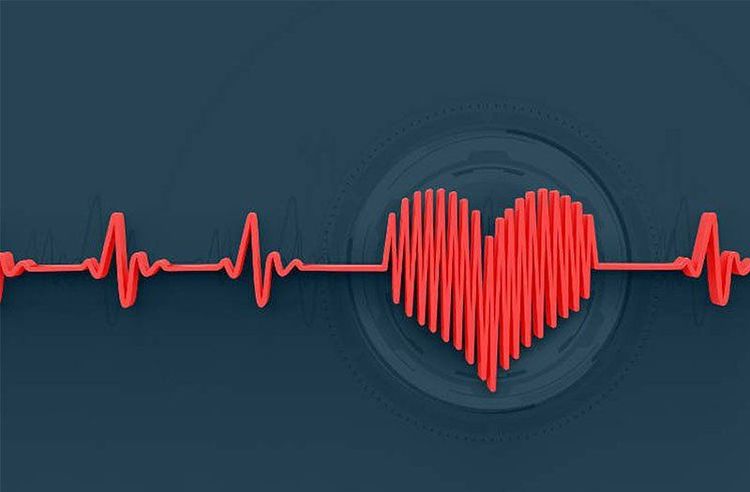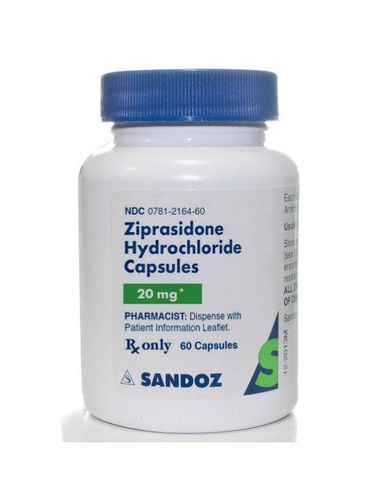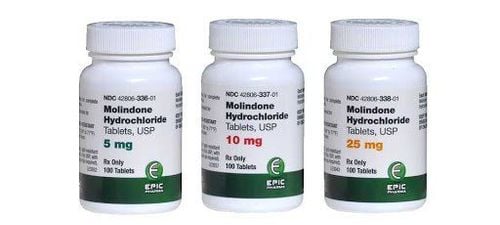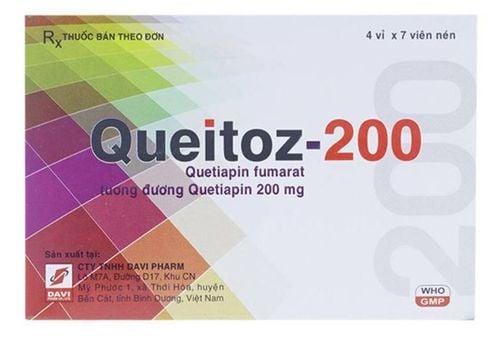This is an automatically translated article.
Clozapine is an atypical antipsychotic. It is mainly used for schizophrenia if the disease has not progressed after the use of other antipsychotic drugs.1. What effect does Clozapine have?
Clozapine is used to treat certain conditions related to mental disorders (schizophrenia, schizoaffective disorder). Clozapine is a psychiatric medication (antipsychotic type) that works by helping to restore the balance of certain natural substances (neurotransmitters) in the brain. Clozapine helps reduce hallucinations and helps prevent suicide in people at risk of self-harm. The medication also helps patients think more clearly and positively about themselves, have less anxiety, and participate in daily life.2. Indications and contraindications
2.1. Indications for treatment-resistant schizophrenia Clozapine is indicated in patients with refractory schizophrenia and in patients with schizophrenia experiencing severe neurological adverse reactions that cannot be treated with other medications. other antipsychotics, including atypical antipsychotics.Resistant is defined as a lack of clinical improvement despite adequate doses of at least two different antipsychotics, including an atypical antipsychotic, prescribed in appropriate duration of treatment.
Psychiatric disorders in patients being treated for Parkinson's disease Clozapine is also indicated for psychiatric disturbances occurring during the treatment of Parkinson's disease, in the event that standard treatment has not been successful.
2.2. Contraindications Hypersensitivity to the active substance clozapine or to any of the excipients. Patients with rare hereditary problems of galactose intolerance, the Lapp lactose deficiency or glucose-galactose malabsorption should not take this medicine. The patient cannot have regular blood tests. History of toxic or isolated agranulocytosis or agranulocytosis (except agranulocytosis or agranulocytosis due to prior chemotherapy). The patient has a history of clozapine-induced agranulocytosis. Decreased bone marrow function. Uncontrolled epilepsy. Psychosis due to alcohol and other poisons, intoxication, coma. Circulatory failure or CNS depression from any cause. Serious kidney or heart disorder (eg, myocarditis). Active liver disease associated with symptoms of nausea, loss of appetite or jaundice; advanced liver disease, liver failure. Intestinal paralysis. Clozapine therapy must not be initiated concurrently with drugs known to cause significant agranulocytosis; Concomitant use of antipsychotics is not recommended.

Thuốc Clozapine được chỉ định cho bệnh nhân tâm thần phân liệt kháng trị
3. How to use Clozapine
Patients taking Clozapine should read the product information leaflet provided by their pharmacist before you start taking clozapine. If you have any questions or concerns about how to use the medicine, ask your doctor or pharmacist for further advice.Clozapine is taken by mouth, patients can take with or without food, as directed by the doctor. If you are taking the medicine in the form of a dissolving tablet, carefully remove each tablet from the blister just before taking it. Allow the tablet to dissolve on the tongue and swallow. The patient does not need to dissolve the tablet with water. Throw away any soluble tablets that have been previously exposed to air due to open or damaged packaging.
If the patient is taking the liquid form of Clozapine, shake the bottle well for 10 seconds before each use. Carefully measure the dose with a special measuring instrument or spoon. Do not use a household spoon because then the patient may not receive the correct dose.
It is important when using Clozapine to start at a low dose, increasing the dose slowly to reduce side effects such as dizziness, drowsiness, and seizures. Patients need to follow the doctor's instructions and orders exactly. Each person's dosage is based on their medical condition and response to therapy. Because clozapine can lower white blood cell counts, patients will need regular blood tests as directed, so be sure to keep all appointments for lab tests.
If the patient misses his dose for longer than a day or two, consult the doctor for how to return to the dose taken. Use Clozapine regularly to get the best treatment effect. To help the patient remember, the doctor or pharmacist should instruct the patient to take the medication at the same time of day.
Do not stop using clozapine on your own without consulting your doctor. Some conditions may get worse when the patient stops taking the medicine suddenly. In addition, patients may experience symptoms such as profuse sweating, headache, nausea, vomiting, and diarrhea. To prevent symptoms while you are stopping treatment with Clozapine, your doctor may reduce your dose slowly. Consult your doctor or pharmacist for more details and report any new or worsening symptoms immediately.
It may take several weeks to see an effect on the patient. Patients should notify their doctor if their condition persists or worsens.

Bạn cần hỏi ý kiến bác sĩ nếu muốn dừng thuốc
4. Drug interactions
Drug interactions can change the way a drug works or increase the risk of serious side effects. The article does not contain all possible drug interactions. Keep a list of all products you are using (including prescription drugs, over-the-counter medicines, and herbal products) and share it with your doctor or pharmacist for advice. Do not start, stop, or change the dose of any medicine without consulting your doctor.One product that may interact with Clozapine is: Metoclopramide.
Certain other medicines may affect the elimination (elimination) of clozapine from the body, which may affect how well Clozapine works. Examples include fluvoxamine, rifamycins (such as rifabutin, rifampin), saquinavir, drugs used to treat seizures (such as carbamazepine, phenytoin), and several others.
Tell the doctor or pharmacist if the patient is taking other products that cause drowsiness such as opioid pain relievers or cough suppressants (such as codeine, hydrocodone), marijuana, alcohol sleeping pills (such as alprazolam), lorazepam, zolpidem), muscle relaxants (such as carisoprodol, cyclobenzaprine), or antihistamines (such as cetirizine, diphenhydramine).
Check the labels on all medications you are taking (such as allergy or cough and cold products) as they may contain ingredients that cause drowsiness. Ask your pharmacist if you can use these products safely.
Smoking can lower blood levels of Clozapine. Patients should inform their doctor if they smoke or have recently stopped smoking.
5. Special precautions and precautions for use
Agranylocytosis Clozapine can cause agranulocytosis. The rates of agranulocytosis and mortality in individuals who are developing agranulocytosis have decreased markedly since white blood cell (WBC) and absolute neutrophil (ANC) counts. . Before starting clozapine therapy, patients should have blood tests and a medical history and physical examination. Patients with a history of heart disease or abnormal cardiac findings on physical examination should be referred to a specialist for other tests that may include an electrocardiogram, and the patient should be treated only if benefit is expected. more obvious than the risk. The treating physician should consider performing an electrocardiogram prior to treatment.Eosinophilia In case of eosinophilia, Clozapine should be discontinued if the eosinophil count rises above 3000/mm3 (3.0 x109/L); Therapy should be restarted only after the eosinophil count falls below 1000/mm3 (1.0 x 109/L).
Thrombocytopenia In the event of thrombocytopenia, clozapine therapy should be discontinued if the platelet count falls below 50000/mm3 (50 x 109/L).
Cardiovascular disorders Orthostatic hypotension, which may be accompanied by syncope, may occur during treatment with Clozapine. These symptoms are more likely to occur with concomitant use of benzodiazepines or any other psychotropic agent and during initial treatment in conjunction with rapid dose escalation; In very rare cases, they can occur even after the first dose. Therefore, patients initiating therapy with Clozapine should be under close medical supervision. Monitoring of blood pressure while standing and supine is essential during the first weeks of treatment in patients with Parkinson's disease.

Thuốc Clozapine có thể gây rối loạn tim mạch
Convulsions Patients with a history of seizures should be closely monitored during treatment with Clozapine because dose-related seizures have been reported. In such cases, the dose should be reduced and anticonvulsant therapy should be initiated if necessary.
QT prolongation As with other antipsychotics, caution should be exercised in patients with cardiovascular disease or a family history of QT prolongation. As with other antipsychotics, caution should be taken when prescribing clozapine with drugs that increase the QT interval.
Anticholinergic effects Clozapine has anticholinergic activity, which can produce undesirable effects throughout the body. Careful monitoring is indicated in cases of prostatic hypertrophy and narrow-angle glaucoma. Possibly due to its anticholinergic properties, clozapine has been associated with varying degrees of impaired bowel motility, from constipation to bowel obstruction, fecal incontinence, and paralytic ileus. Special care is needed in patients who are being treated with medications that are also constipating, have a history of colon disease, or have a history of lower abdominal surgery. It is important that constipation is recognized and treated aggressively.
Fever During Clozapine therapy, patients may experience a transient increase in temperature above 38°C, with the highest incidence within the first 3 weeks of treatment. This fever is generally benign. Sometimes, it may be related to an increase or decrease in the white blood cell count. Patients with fever should be carefully evaluated to exclude the possibility of a common infection or the development of agranulocytosis. In the case of high fever, the possibility of neuroleptic malignant syndrome (NMS) must be considered. If a diagnosis of NMS is confirmed, Clozapine should be discontinued immediately and appropriate medical measures instituted.
Metabolic changes Atypical antipsychotics, including clozapine, are associated with metabolic changes that may increase cardiovascular or cerebrovascular risk. These metabolic changes may include hyperglycemia, dyslipidemia, and increased body weight. Although atypical antipsychotics can produce some metabolic changes, each drug in the class has unique effects.
Hyperglycemia Impaired glucose tolerance or risk of further progression of diabetes has been reported with clozapine treatment. Patients with a confirmed diagnosis of diabetes at the start of treatment with atypical antipsychotics should be monitored regularly to control blood glucose levels. Patients with risk factors for diabetes (eg, obesity, family history of diabetes) who are initiating treatment with atypical antipsychotics should have their fasting blood glucose tested when initiation of treatment and periodically throughout the treatment period. Patients who develop symptoms of hyperglycemia during treatment with atypical antipsychotics should have a fasting blood glucose test.
Dyslipidemia Undesirable changes in blood lipids have been observed in patients treated with atypical antipsychotics, including clozapine. Clinical monitoring, including initial lipid profile and periodic monitoring, is recommended in patients receiving clozapine.
Weight gain Weight gain has been reported with the use of atypical antipsychotics, including clozapine. Encourage patients to monitor their weight while taking the drug.

Người bệnh nên theo dõi cân nặng khi sử dụng thuốc Clozapine
Withdrawal syndrome on discontinuation Acute withdrawal reactions have been reported following abrupt discontinuation of clozapine , therefore it is recommended that the drug be discontinued gradually. If abrupt discontinuation is required (eg, due to leukopenia), patients should be carefully monitored for recurrence of psychotic symptoms and symptoms associated with cholinergic recovery, such as vomiting. profuse sweating, headache, nausea, vomiting and diarrhea.
Reference source: Webmd.com, eMC













